|
SIGGRAPH celebrated it's twenty-fifty anniversary at the 1998 conference in Orlando this July. As part of the celebrations, an
exhibit was prepared of 12 images from each of 10 influential research labs in computer graphics. The Program of Computer Graphics displayed the following twelve images, which stress important historical developments in computer graphics.
 caption: Johnson Art Museum from "Cornell in Perspective" animation
caption: Johnson Art Museum from "Cornell in Perspective" animation
credits: Donald Greenberg el. al., 1973
explanation: 1973 - Donald Greenberg and his students
modeled much of Cornell's campus to make one of
the first color computer graphics simulations, Cornell in Perspective.
This Scientific American cover image of Cornell's Johnson Art Museum
accompanied an article introducing computer graphics
for use in architecture. Work was conducted at General Electric's Visual Simulation
Lab in Syracuse, N.Y.
 caption: Early computer animation cell using Cornell's paint & fill system
caption: Early computer animation cell using Cornell's paint & fill system
credits: Marc Levoy, 1977
explanation:
1977 - Marc Levoy, Bruce Wallace and others developed an early computer animation system for the production of television cartoons. The system, used by Hanna-Barbera, revolutionized cartoon production.
 caption: Early ray-traced coke bottle on Cornell Arts Quad
caption: Early ray-traced coke bottle on Cornell Arts Quad
credits: Doug Kay, 1979
explanation:
1979 - Doug Kay was one of the first to use ray tracing techniques
including refraction effects and accurate light attenuation.
 caption: Cook-Torrance light reflection model
caption: Cook-Torrance light reflection model
credits: Rob Cook & Ken Torrance, 1981
explanation:
1981 - Rob Cook and Ken Torrance introduced
a realistic lighting model based on geometric optics.
The model simulated a wide variety of rough surfaces,
allowing metallic and plastic surfaces to be correctly rendered.
 caption: Kitchen ray-traced with shadow buffer
caption: Kitchen ray-traced with shadow buffer
credits: Eric Haines, 1985
explanation:
1985 - Eric Haines developed the Shadow Buffer algorithm,
greatly reducing the computation time for ray traced images.
By precomputing some occlusion information,
environments with complex geometry and many lights
could now be ray traced more efficiently.
 caption: Early, complex radiosity image of steel factory
caption: Early, complex radiosity image of steel factory
credits: Stu Feldman & John Wallace, 1987
explanation:
1987 - Stuart Feldman and John Wallace used a modified version of the hemicube radiosity algorithm to produce this image in 195 hours on a DEC Vax 8700. The environment consisted of about 55,000 elements, demonstrating that the radiosity approach could be extended to complicated scenes.
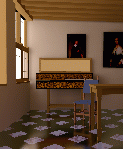 caption: Verneer studio with two-pass rendering
caption: Verneer studio with two-pass rendering
credits: John Wallace & Micheal Cohen, 1987
explanation:
1987 - John Wallace and Michael Cohen combined
the diffuse lighting effects of radiosity
with the specular contributions of a view-dependent algorithm
to produce the first "two-pass" rendering method.
Such hybrid renderers are now available in commercial software.
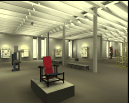 caption: Museum simulation with progressive radiosity
caption: Museum simulation with progressive radiosity
credits: Eric Chen, Michael Cohen, 1989
explanation:
1989 - Eric Chen and Michael Cohen
made this image using a progressive radiosity algorithm
that performed the most important calculations first. This model contains approximately 2000 light sources.
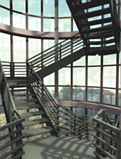 caption: Rhodes Hall stair tower with soft shadowing
caption: Rhodes Hall stair tower with soft shadowing
credits: Keith Howie & Ben Trumbore, 1989
explanation:
1989 - Keith Howie and Ben Trumbore
used blueprints and material samples
to simulate the lab's new building before it was complete.
This image of the building's stair tower
was computed with a ray tracer using soft shadowing techniques.
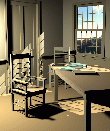 caption: Radiosity with discontinuity meshing
caption: Radiosity with discontinuity meshing
credits: Dani Lischinski & Filippo Tampieri, 1993
explanation:
1993 - Dani Lischinski and Fillipo Tampieri
greatly improved radiosity images with their
discontinuity meshing algorithms.
Instead of meshing the surfaces with grids,
subdivisions were created along shadow boundaries,
which also reduced the mesh size and computation time.
 caption: Louvre Glass Pyramid, 33 million triangles
caption: Louvre Glass Pyramid, 33 million triangles
credits: Sean Barry & Ben Trumbore, 1995
explanation:
1995 - Sean Barry and Ben Trumbore modeled and ray traced
I.M. Pei's glass pyramid at the Louvre museum.
The 33 million triangle model is one of the most complex scenes rendered to date.
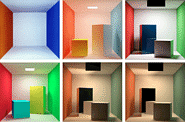 caption: Cornell Box sequence leading to comparison of rendering with physical image
caption: Cornell Box sequence leading to comparison of rendering with physical image
credits: Goral, Cohen, Sillion, Lischinski/Tampieri, Shirley, 1984-96
explanation:
The Cornell Box has seen it all:
1984 - Cindy Goral's original Cornell Box
1985 - Michael Cohen's hemicube made occlusion possible for radiosity.
1991 - Francois Sillion's spherical harmonics added specularity.
1993 - Lischinski and Tampieri's discontinuity meshing improved shadow quality.
1996 - Pete Shirley compared measured and simulated images,
finding algorithmic errors.
|  caption: Johnson Art Museum from "Cornell in Perspective" animation
caption: Johnson Art Museum from "Cornell in Perspective" animation caption: Early computer animation cell using Cornell's paint & fill system
caption: Early computer animation cell using Cornell's paint & fill system caption: Early ray-traced coke bottle on Cornell Arts Quad
caption: Early ray-traced coke bottle on Cornell Arts Quad caption: Cook-Torrance light reflection model
caption: Cook-Torrance light reflection model caption: Kitchen ray-traced with shadow buffer
caption: Kitchen ray-traced with shadow buffer  caption: Early, complex radiosity image of steel factory
caption: Early, complex radiosity image of steel factory caption: Verneer studio with two-pass rendering
caption: Verneer studio with two-pass rendering caption: Museum simulation with progressive radiosity
caption: Museum simulation with progressive radiosity  caption: Rhodes Hall stair tower with soft shadowing
caption: Rhodes Hall stair tower with soft shadowing caption: Radiosity with discontinuity meshing
caption: Radiosity with discontinuity meshing caption: Louvre Glass Pyramid, 33 million triangles
caption: Louvre Glass Pyramid, 33 million triangles caption: Cornell Box sequence leading to comparison of rendering with physical image
caption: Cornell Box sequence leading to comparison of rendering with physical image